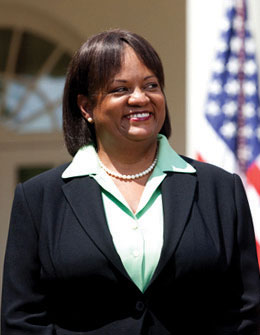Edward (Ted) Kennedy, at the 1980 Democratic National Convention, began his speech with a short tribute and acknowledgement to the previous speaker, member of Congress Barbara Mikulski:
Thanks very much, Barbara Mikulski, for your very eloquent, your eloquent introduction. Distinguished legislator, great spokeswoman for economic democracy and social justice in this country, I thank you for your eloquent introduction.
Refer to Personal Interest
One of the key considerations in choosing an appropriate topic for your speech is that you have a personal interest in that topic. An effective attention getter then, can be your description of that personal interest. By noting your personal interest, you will demonstrate your credibility by showing your knowledge and experience with this topic, and because you have a personal interest, you are more likely to present this information in a lively and clear manner—again, enhancing your credibility. Referring to your personal interest in this topic in the introduction also helps you set the stage for additional anecdotes or examples from your personal experience later in the speech.
In speaking at the 1992 Democratic National Convention, Elizabeth Glaser began her speech by acknowledging her very personal interest in the topic:
I’m Elizabeth Glaser. Eleven years ago, while giving birth to my first child, I hemorrhaged and was transfused with seven pints of blood. Four years later, I found out that I had been infected with the AIDS virus and had unknowingly passed it to my daughter, Ariel, through my breast milk, and my son, Jake, in utero.
Use Startling Statistics
Startling statistics startle an audience and catch its attention and encourage that audience to listen further as you present the context of the surprising statistic. Long-time radio announcer Paul Harvey is well known for the catch phrase “And now, the rest of the story.” The same function should be at work here. When you startle the audience, you set them up to want to hear the “rest of the story.”
Be careful, though. Use of startling statistics requires that you do a number of things. First, make sure the statistic is accurate. Second, make sure the statistic is relevant to the topic of the speech. Startling an audience with an irrelevant statistic diminishes the speech and decreases your credibility. Third, make sure you then present “the rest of the story.” You need to place this startling statistic in the context of your speech so that everything fits together.
One speaker used an effective startling statistic to help introduce a speech on the dangers of heart disease:
According to the Center for Disease Control, in the United States 26.6 million adults have heart disease. This would be about 12% of adults, or three people in this room.
Use an Analogy
Analogies compare something that your audience knows and understands with something new and different. For your speech, then, you can use an analogy to show a connection between your speech topic (something new and different for the audience) and something that is known by your audience.
One very common (and often misquoted) analogy comes from the 1919 Supreme Court case of Schenck v United States. Justice Oliver Wendell Holmes used this analogy to support his reasoning that some forms of expression can be suppressed because they present a “clear and present danger.” Holmes noted that “[t]he most stringent protection of free speech would not protect a man falsely shouting fire in a theater and causing a panic.”
Use a Quotation
Using a quotation from a well-known figure or using a quotation from a lesser-known figure if the quotation is particularly suitable for your speech topic, is a common attention-getting technique. When you quote that well-known figure, you are in a sense, borrowing some of that person’s credibility for your speech, enhancing your credibility with the audience. Even when you use a less than well-known figure, the quotation can be effective if it nicely sets up
your speech topic and is something to which your audience can relate.
Be careful with quotations, however. First, just using the quotation is not sufficient. You need to place the quotation in the context of your speech (as well as meet the other required functions of an introduction, of course). Second, it is easy to fall into a bad (and somewhat lazy) habit of simply finding a quotation and using it to start every speech. Third, simply using a quotation is no guarantee that your audience will find that quotation interesting or apt for the speech and may also find the author of the quotation to be lacking in credibility—or your audience may simply not like the author of the quotation. Finally, beware of overly- long quotations (three or more sentences): Remember, this is just part of the introduction, not a main point of the speech.
In his farewell address, former President Ronald Reagan (1989) utilized a very short quotation to emphasize his feelings upon leaving office.
People ask how I feel about leaving. And the fact is, “parting is such sweet sorrow.” The sweet part is California and the ranch and freedom. The sorrow — the goodbyes, of course, and leaving this beautiful place.
Ask a Question
Using rhetorical questions in speeches is a great way to keep the audience involved. Don’t you think those kinds of questions would keep your attention? – Bo Bennett
The use of questions can be a very effective way to get attention, whether those questions are rhetorical in nature, and are only meant to be considered and pondered by the audience or are meant to be answered by the audience (generally a good technique to get audience involvement and interest).
Rhetorical questions are designed to allow you as speaker to get the audience to think about your topic without actually speaking the answer to the question. Rhetorical questions allow you as speaker to maintain the most control over a speech situation and allow you to guard against an inappropriate or even offensive response.
Using questions that ask for real responses, however, has additional benefits, if a speaker feels comfortable with the audience, and is able to handle some impromptu situations. Getting the audience to physically and verbally involve themselves in your topic guarantees that they’re paying attention. Using questions that lead to positive answers can also enhance your connection to and credibility with the audience.
Starting a speech with a question whether rhetorical or actual does require thought and practice on your part. You need to carefully consider the question and possible answers. Remember—even if you think the question is rhetorical, your audience may not know this and may answer the question. You also need to carefully deliver the question. Too often, speakers will use a question as an introduction—but then give the audience no time to either think about the answer or answer the question. You need to use timing and pause when starting with a question. You also need to be careful to use eye contact in asking questions, since you are above all asking for audience involvement, and your eye contact requests that involvement.
It is not enough for me to ask questions; I want to know how to answer the one question that seems to encompass everything I face: What am I here for? – Abraham Joshua Heschel
In 1992, Ross Perot selected a little-known retired military figure, Admiral James Stockdale, as his Vice-Presidential running mate. In the fall debates, Stockdale began his opening statement with two questions: “Who am I? Why am I here?” (Stockdale, 1992). The questions received applause and also laughter, though the later reaction to these questions was mixed at best. Some saw this as confusion on the part of Stockdale. Stockdale considered these two questions to illustrate his difference from the other two “mainstream” candidates, Al Gore and then Vice President Dan Quayle. Traditional politicians, Gore and Quayle were readily recognized as compared to Stockdale.













